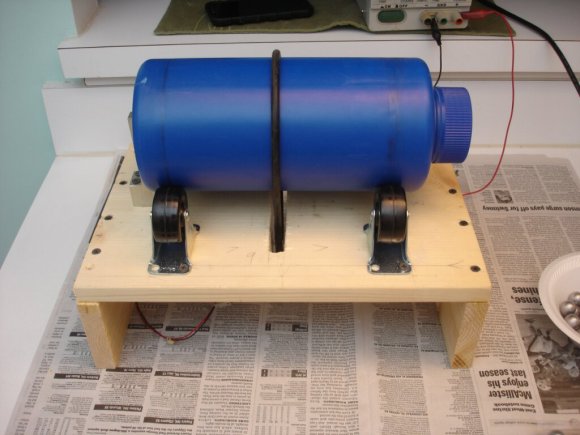 [Mike] enjoys doing all kinds of things with glass. He likes to melt it and fuse it into new things, so it’s perfectly understandable that he wanted to make his own glass. Doing so requires finely ground chemicals, so [Mike] put together this awesome homemade ball mill.
[Mike] enjoys doing all kinds of things with glass. He likes to melt it and fuse it into new things, so it’s perfectly understandable that he wanted to make his own glass. Doing so requires finely ground chemicals, so [Mike] put together this awesome homemade ball mill.
The design is wonderfully simple. The mill is powered by a robust 12VDC motor from a printer that he’s running from a variable power supply in order to fine tune the speed. [Mike] built a scrap wood platform and attached four casters for the drum to spin against. The drum is rotated by a round belt he had lying around from various other projects. [Mike] already had a couple of those blue containers, which formerly held abrasive grit for use in vibratory tumblers.
[Mike] had some trouble with the drum walking off the casters so he attached scrap piece of aluminum to form an end stop. All he had to buy for this project were the 5/8″ steel balls and the casters. The mill can also be used as a rock tumbler, though the bottle isn’t quite water tight as-is. He does not recommend this type of setup for milling gunpowder or other explosives, and neither do we.
Make the jump to see the mill in action and get the grand tour. If you need more tumbling power, use a dryer motor!















Steak tenderizer? :)
With all your seasonings thrown in as well. That’d be amazing.
Kiah, the seasonings suggestion just took this from a great idea… to genius!
How much time does it take for a typical run in this application?
It depends on various factors:
-Size of balls or ceramic pieces
-amount of polish desired
But tipically, I remember commercial machines that have times that range from five minutes to two hours.
Also, be careful, they can get LOUD!
Probably in the order of days. You are limited by gravity that has to supply the grinding force. An industrial one will have a centrifugal action in addition to the tumbling, to supply much more force to the medium. Those indeed can have milling times of a few hours.
That is quite interesting, I’ll build one for myself with that design, so simple!
Lead balls and maybe static grounding and that rig would be great for milling blackpowder. Very nice build!
No, the two steel balls striking each other could potentially cause a spark. There is a reason why they make beryllium copper tools for working on oil rigs and whatnot.
http://en.wikipedia.org/wiki/Beryllium_copper#Uses
Or, as jordan said, lead balls work fine. They are used professionally as non sparking media in pyrotechnic manufacturing.
I dont know how I overlooked that.
Dry sand and rusty screws, small parts etc. Nice!
A little bit of aluminum and you could build this (and some inert gas i suppose) rocket propellant:
http://en.wikipedia.org/wiki/ALICE_%28propellant%29
Yesterday I was wondering if you could use this for polishing 3D printed plastic parts.
Does anyone have some experience with plastic?
Yes, I have read some reports of using a vibratory polisher on PLA printed parts. It worked quite well, so this might too. I would not want to sit next to this machine when it’s running though.
Though it is part of a larger article, I’ve included a ball mill. built with K’nex: http://www.science20.com/square_root_not/science_play_and_research_kit_business_models_packaging_and_marketing_part_2-123686
Wouldn’t it be better if the drum was hexagonal (or some other shape) instead of round? Thats the way my Thumblers (rotary) Tumbler is. If I recall correctly it causes the media to move around more than simply spin on the bottom of the drum.
Also what is the chance two of the steel balls cause a spark, potentially igniting whatever fine chemical you’re milling, causing something similar to a grain explosion?
I used materials that were immediately at hand. If you have a hex shaped drum, use it. If you’re using the ball mill to mix black powder, then you might want to use the porcelain black powder mill balls purchased from a gun shop.
I had to view the source to get a closer look at that aluminum piece. From the image in this article, I imagined this turning into a slow plastic lathe. Now it’s just friction instead of scraping. Wonder if it causes enough drag on the drum to warrant replacing with a horizontal wheel or something instead? Can’t watch the video at work, so I really am curious.
Great inspiration for my solid (ingredients) mixer. Thanks.
That’s not plywood.
Ahh, thank you. How embarrass-king.
Looks more sturdy than the Harbor Freight models.
Has anyone had any experience ball milling aluminum powder to upgrade it’s quality to that of German dark? I’m interested in hearing the results of their work.
Also, were there any adverse effects or dangers observed while doing so?